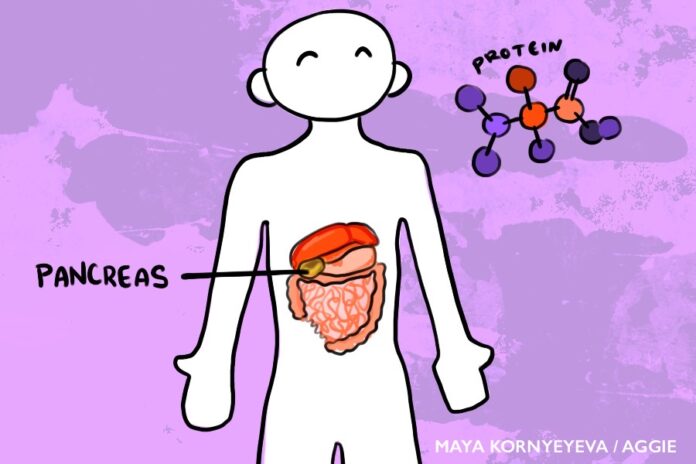Targeting the protein could lead to effective treatments for pancreatic cancer
By ARYAMAN BHATIA — science@theaggie.org
Researchers at UC Davis have published a study that has shown the Engrailed-1 (EN1) protein supports the advancement of pancreatic cancer and its spread to other parts of the body (metastasis) using laboratory cultures and mouse models.
“Pancreatic cancer is the third leading cause of cancer-related deaths in the United States with [a] 12% 5-year relative survival rate, lowest among all common cancers,” the study reads.
The researchers discovered a correlation between high levels of EN1 and the severity of pancreatic cancer, particularly its tendency to metastasize, in human patients. This finding can lead to possible treatments for pancreatic cancer, which is currently one of the hardest cancers to treat.
The project started out by studying the metastatic process of pancreatic cancer. The metastatic process refers to the spread of cancer cells from the original (primary) tumor to other parts of the body, where they can form new tumors.
“Metastasis is an important component of pancreatic cancer progression, but researchers have not been able to identify genetic mutations responsible for it,” an article from UC Davis states.
Reno Jihao Xu, a doctoral student involved in the project, commented on the process of discovering the protein.
“Initially, we were studying the metastatic process of pancreatic cancer and through various analyses we identified a transcription factor which is a protein,” Xu said. “Transcription factor goes into the cell nucleus, turning on or off the transcription of certain genes. What this means is that it controls the genotype to phenotype process, therefore carrying out a subsequent function; in this case, promoting the metastatic process. So this project is about characterizing the functionality of this protein by looking at what genes this protein targets as well as how the protein regulates this gene through various experiments.”
In order to identify this protein, the teams used a non-traditional technique.
”We identified this protein through the utilization of a technology called Organoid, which is a 3D modeling of cells,” Xu said. “This technology well-preserves the biological characteristics of a tissue, in this case, the cancer cells, which allows us to characterize or identify the differences between the different stages of cancer progression, such as primary tumor versus metastasis.”
Due to the recently discovered nature of EN1, finding effective ways to stop the progression requires less traditional methods and creative thinking.
“There are no therapeutics that can target this protein on the market because of the unique structure that does not allow for the development of therapeutics,” Xu said. “So, what we can go about is identifying what other proteins can interact with this protein that are important to carry out its downstream pathways. To do this, we perform an experiment called immunoprecipitation followed by mass spectrometry. This experiment allows us to identify all the proteins that interact with this protein, and one of them is called DH2. It modifies the histones on the genetic level to regulate gene expressions, so perhaps we could combine these DH2 inhibitors with chemotherapy to see if there’s any differential regulation or differential response from the combination of therapy.”
Finding the protein responsible was incredibly difficult and complicated for the team.
“For a very long time we tried different strategies to identify the genomic binding regions of the EN1, and that took up about two years,” Xu said. “We tried almost everything and finally it worked out.”
When further asked what helped make the project successful, Xu highlighted the importance of collaboration and communication amongst all members of the scientific community.
“I started the project when COVID first hit,” Xu said. “So, it was basically just myself inside a lab, and it was really difficult to interact with other labmates. Science is a collaborative effort, so I definitely felt powerless doing the science by myself.”
Xu mentioned what he finds to be one of the most important parts of making the project come to life.
“I would really like to emphasize teamwork because innovation doesn’t come through one single individual; it comes through daily interaction with colleagues, or with other investigators,” Xu said. “All of this is teamwork, and without teamwork, there is no discovery, [and] there is no scientific achievement.”
Written by: Aryaman Bhatia — science@theaggie.org





